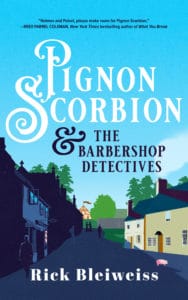By Rick Bleiweiss
If you’re going to write a novel set in the past, be prepared to do a massive amount of research. Both of my first two books—Pignon Scorbion & the Barbershop Detectives and Murder in Haxford—are set in a countryside market town in 1910 England.
I had to conduct much more research than I would have ever imagined when I first started writing my historical fiction mystery series.
Even though my series’ setting is pure fiction, my goal is to transport readers back to a long-ago time and place. I want my novels, their every detail and event, to be believable, authentic, and accurate to that time. To achieve that, the minutiae must be correct.
The devil is in the details
Among the things that I, and anyone writing historical fiction, need to get right are the language and slang spoken in the book’s time and place, names that were popular then, the “look” of the towns and/or cities, what businesses flourished in them, the clothes people wore, and real-life events that could be germane to the plot.
Consider some of the detail that I investigate—which should be considered by any writer of historical fiction: what lighting is used in stores and homes (gas, oil, electricity, etc.), the jobs characters are engaged in, the current-day state of communication and transportation, what books, songs and paintings are popular—and, of course, much more. I feel that incorporating this level of detail is absolutely necessary to have my stories feel realistic.
Finding the right Beta readers
After finishing my first drafts, I had quite a few helpful Brits do sensitivity and accuracy reads. After all the research I had done, I was surprised at all the many things they pointed out that needed to be corrected.
What’s in a name?
 When I first developed the idea for my protagonist Scorbion, I realized that I wanted him to have an unusual name, but also one that people would remember. The character has an Egyptian father and a Haitian mother, so I began researching what his family name might be. When seeking an Arabic or Egyptian name from that era, I came upon Scorbion. The name stood for many of the character traits the character’s father possessed: adventurous, fair, entrepreneurial. Taking a real liking to the name, I adopted it for my book’s hero.
When I first developed the idea for my protagonist Scorbion, I realized that I wanted him to have an unusual name, but also one that people would remember. The character has an Egyptian father and a Haitian mother, so I began researching what his family name might be. When seeking an Arabic or Egyptian name from that era, I came upon Scorbion. The name stood for many of the character traits the character’s father possessed: adventurous, fair, entrepreneurial. Taking a real liking to the name, I adopted it for my book’s hero.
Next, his surname: through extensive research, I discovered that Haiti had both a mountain and a valley named Pignon—named after a French explorer of the region. I decided to make that where my protagonist’s father and mother had met, and subsequently they named their son after the area.
Down the research rabbithole…with great results!
At every turn in the writing of the book, I found yet another area of research that needed to be done. One of the series characters, Thelma Smith, owns a bookshop so I needed to know what books were popular in England in the early 1900s. I had to make certain that Haxford’s art gallery was displaying paintings appropriate to the time period. The characters that walked its streets had to wear clothing representative the summer of 1910, and the local police station had to be authentic down to the Union Jack hanging on its wall. Additionally, to be historically correct I determined what real-world events had taken place just prior to my story, as well as those that were taking place as it unfolded.
I figured out what the barbershops looked like in 1910 and what implements barbers like my character Calvin Brown used. I sought to learn the state of telephones and telegraphy, and what measurements and money were used in Britain at the time. I didn’t know before conducting my research that in that era Britain was using miles, not kilometers. I found out what foods people ate, the materials their buildings were made out of, the furnishings that were common. I found that the file cabinet had only recently come into use! Also, what transportation was in vogue? At the time, there were both horse-drawn carts and the earliest cranked motor cars.
One case that Scorbion had to solve involved a stilt walker in a circus, so of course I had to research what materials stilts were made of and how tall the stilts of the time were. I discovered what a circus would look like in that day and age, and the historically accurate British titles of the circus jobs.
Finding new plot twists
Looking into the politics, causes, and issues of the time led me to have one of the books’ characters become involved in the suffragette movement. Also, I found out that King George V had ascended to the British throne only a month before the setting of the book—I had to include a mention of that.
That’s not all I had to research, but the above should give any writer of an historical novel an idea of the scope of facts, figures, trends, and demographics they need to nail down to make their book accurate and believable – even if it’s fiction.
Utilize libraries and librarians, the Internet, as well as history and location experts. Researching my book not only added authenticity, it also provided me with new plot ideas. Further, I’m convinced drilling down to that fine level of detail makes for a much more enjoyable read.
What details do you include to lend your book authenticity? Share your secrets with us on Facebook.

 About the author: Rick Bleiweiss started his career in music as a rock performer, producer of over fifty records (including a Grammy nomination), songwriter and record company senior executive, working with Clive Davis, Melissa Etheridge, the Backstreet Boys, Kiss, U2, Whitney Houston, The BeeGees, and other industry legends.
About the author: Rick Bleiweiss started his career in music as a rock performer, producer of over fifty records (including a Grammy nomination), songwriter and record company senior executive, working with Clive Davis, Melissa Etheridge, the Backstreet Boys, Kiss, U2, Whitney Houston, The BeeGees, and other industry legends.
Since 2006 as a publishing company executive, he has acquired works by bestselling and award-winning authors including James Clavell, Gabriel Garcia Marquez, Rex Pickett, Leon Uris, and Catherine Coulter among many others.
Follow Rick & Scorbion at www.rickbleiweiss.com.





